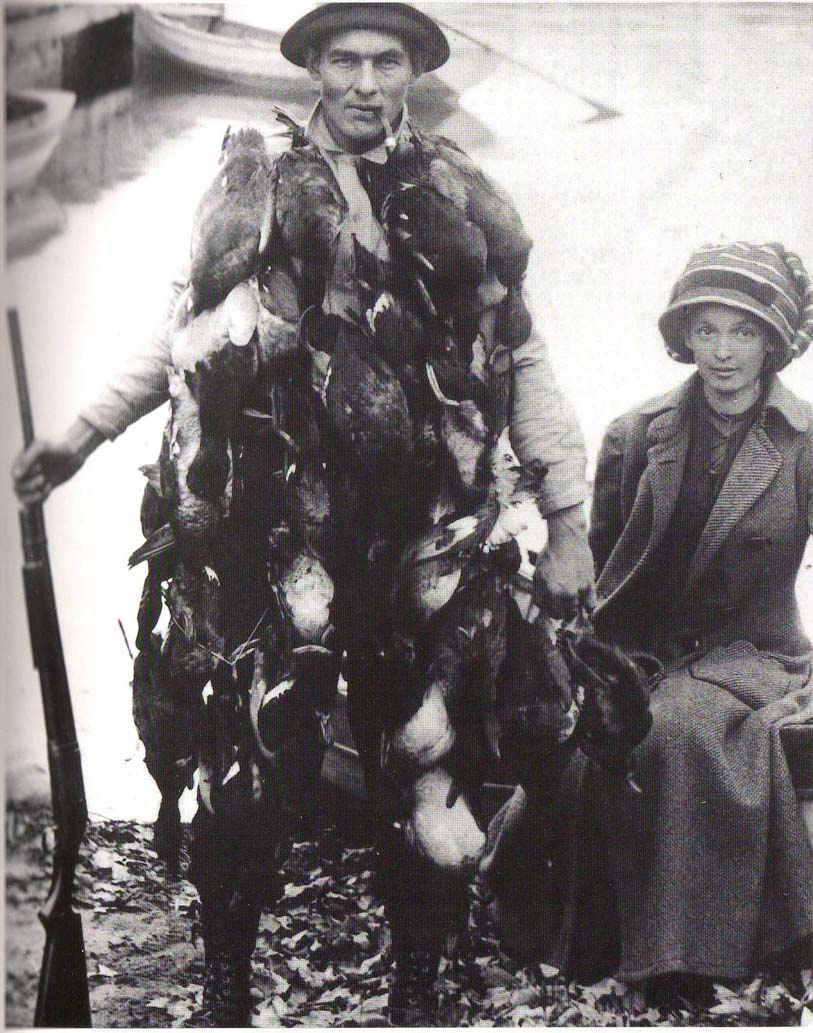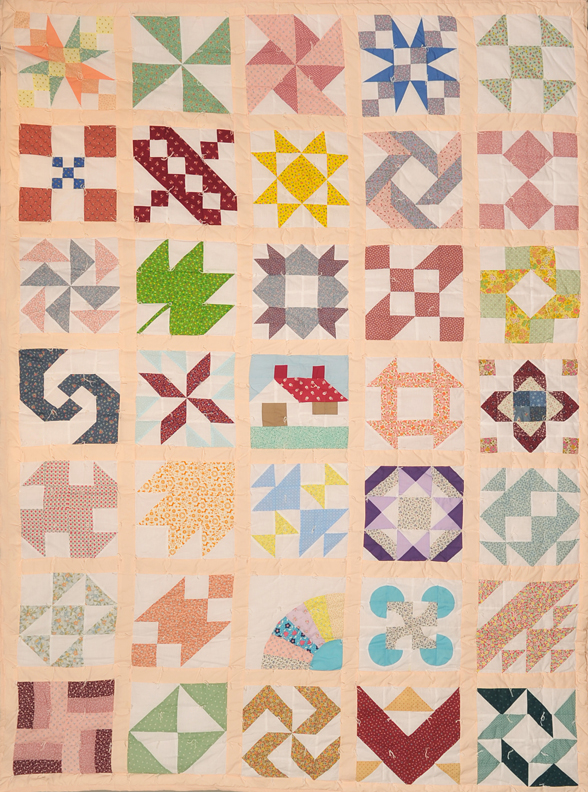Function:
Making it Useful
 Some
artists and their communities place high value on the usefulness of
the objects they create.
Some
artists and their communities place high value on the usefulness of
the objects they create.
Design, materials, and execution all contribute to usefulness, an important aspect of the "aesthetic" in such things as folk furniture, utensils, and crafts.
The look of durability and the object’s ability to stand up to its intended use are also important goals of the artist.
Case Study
St. Lawrence River
Decoy Carvers
Each spring and fall, numerous species of migrating birds seek refuge in the St. Lawrence River’s many shoals, bays, and marshes. A successful day’s hunting requires more than just good marksmanship. It also rests on the hunter’s ability to bring the birds within shooting range. Carved and painted models of birds, thus known as decoys, became essential tools for the hunter trying to lure the passing birds out of the sky. At one time, a hunter typically produced only a few decoys for his personal use. Some carvers, however, created hundreds of decoys that have found their way into the water, and later onto mantelpieces in—and well beyond—the St. Lawrence River valley.
Although decoys were originally conceived and produced as functional objects, the skill and artistry of several carvers in the region—from Cape Vincent to Akwesasne—resulted in nothing less than works of art. While the days of market hunting over a large rig of decoys are long gone, there are a few carvers who still create “working” or “gunning” decoys for themselves, contests, or the purist sportsman/ collectors.
Photo above: Duck hunter and decoy carver Frank "Goldie" Coombs of Alexandria Bay and his wife Abby with a large day's catch in 1917, when market hunting was still legal.
All of these examples of St. Lawrence River duck decoys were created to be used for hunting. The earliest of these birds have minimal carving and simple painting, especially by today’s standards. Their simplicity worked for hunters and appealed to others who saw artistry in their graceful lines and coloration. With cheaper commercially made decoys common now, few hunters carve their own birds anymore; if they do, they are unlikely to hunt with them, as they are more valuable as collectible “wildfowl art.”
Broadbill Drake
Chauncey Wheeler, Alexandria Bay, ca. 1910-30
Courtesy of Tom Eckert
Black Duck Drake
Sam Denny, Clayton, ca. 1930s
Courtesy of Tom Eckert
Whistler Drake
Frank Coombs, Alexandria Bay, ca. 1920-1930
Courtesy of Tom Eckert
Black Duck Drake
Rosh Douglas, Ogdensburg, ca. 1940-1950
Courtesy of Tom Eckert
Whistler Drake
Frankie Louis, Ogdensburg, 1910-1925
Courtesy of Tom Eckert
Whistler Drake
Dick Hollis, Ogdensburg, ca 2002
Courtesy of the artist
Pintail Drake
Don Morley, Heuvelton, ca. 2000
Courtesy of the artist
Ice Fishing Tip-up
A. E. Beckstead, Lisbon, ca. 1940
Courtesy of Varick & Judy Chittenden
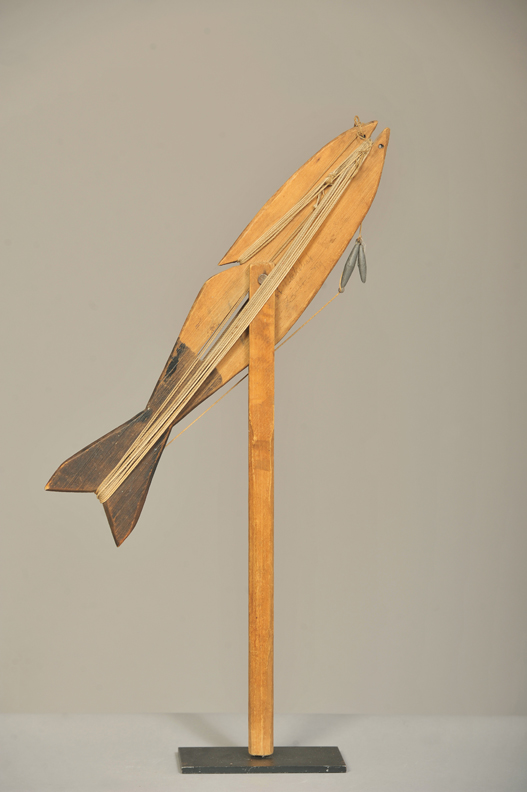 A tip-up is an ice fisherman’s tool that is suspended over a hole cut in the ice and holds line, hook, and bait. Once a fish bites, the tip-up bobs to alert the waiting fisherman. Before modern mechanical tip-ups, people often made their own, decorating them so they could easily distinguish them from those of others fishing in the area. This tip-up was one of about 25 in a set made and used by A. E. Beckstead on Black Lake and the St. Lawrence River.
A tip-up is an ice fisherman’s tool that is suspended over a hole cut in the ice and holds line, hook, and bait. Once a fish bites, the tip-up bobs to alert the waiting fisherman. Before modern mechanical tip-ups, people often made their own, decorating them so they could easily distinguish them from those of others fishing in the area. This tip-up was one of about 25 in a set made and used by A. E. Beckstead on Black Lake and the St. Lawrence River.
Decorated Salt Glaze Stoneware
Two-Gallon Jug with Fish
W. Hart Pottery, Ogdensburg[h], ca. 1858-1869
Courtesy of Allan P. Newell
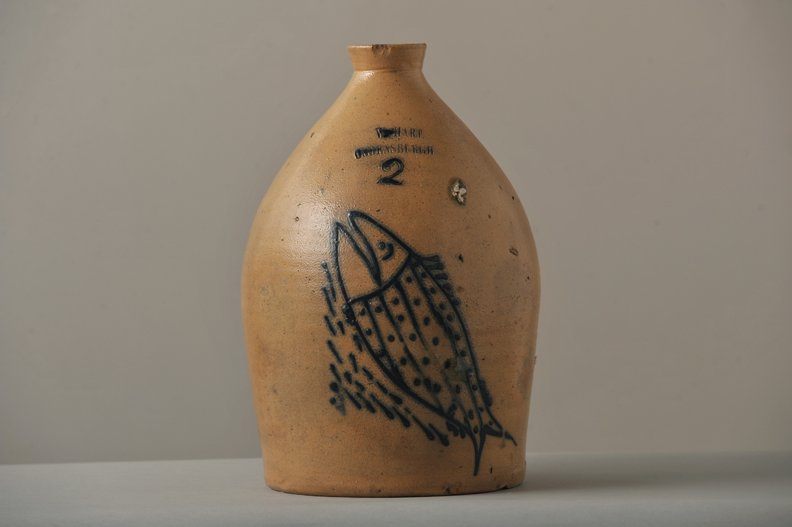 Before modern refrigeration, many cooks owned utilitarian stoneware containers like this to prepare or store food items. There were numerous local potteries in New York State in the 19th century, prominent among them shops owned by the Hart family in Fort Edward and Ogdensburg. Potters would often decorate the earth tones of the pots with simple motifs made with a cobalt blue slip glaze, to make them more appealing as functional and decorative objects in rural homesteads of the time.
Before modern refrigeration, many cooks owned utilitarian stoneware containers like this to prepare or store food items. There were numerous local potteries in New York State in the 19th century, prominent among them shops owned by the Hart family in Fort Edward and Ogdensburg. Potters would often decorate the earth tones of the pots with simple motifs made with a cobalt blue slip glaze, to make them more appealing as functional and decorative objects in rural homesteads of the time.
Four-Gallon Churn with Bird
W. Hart Pottery, Ogdensburg[h], ca. 1858-1869
Courtesy of Allan P. Newell
Three-Gallon Jug with Horse Head
W. Hart Pottery, Ogdensburg[h], ca. 1858-1869
Courtesy of Allan P. Newell
Three-Gallon Crock with Eagle
W. Hart Pottery, Ogdensburg[h], ca. 1858-1869
Courtesy of Allan P. Newell
C. Foot’s Hotel Sign
Unidentified artist, Canton, ca. 1815
Courtesy of St. Lawrence University and St. Lawrence County Historical Association
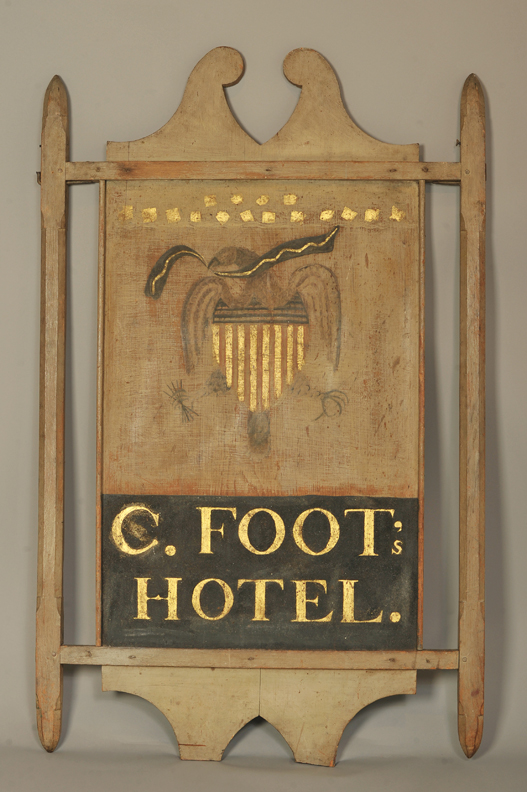
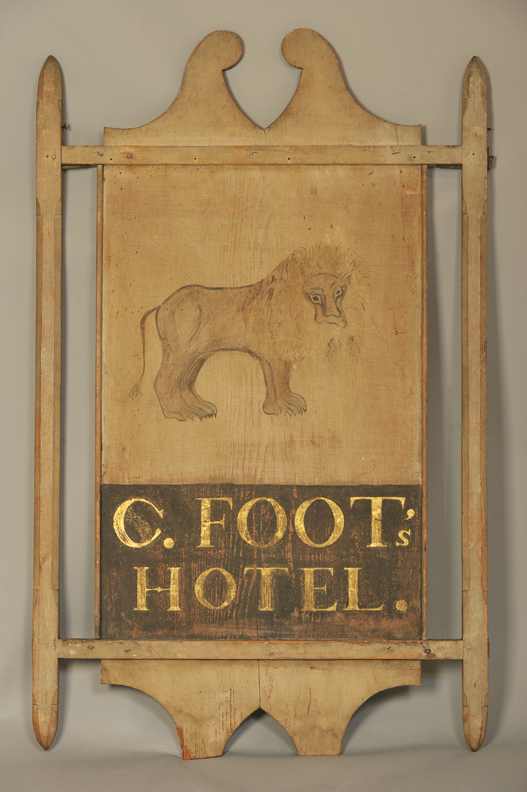 This trade sign is believed to have hung outside the earliest tavern in Canton, first owned by town founder Stillman Foote, later by his nephew Chauncey. Signs like these were made for all kinds of commercial establishments, often in shapes or with decorations that easily identified the kind of business inside. This sign, decorated with the American eagle on one side and the British lion on the other, probably was meant to attract travelers seeking lodging or food from both sides of the St. Lawrence River, when Canada was still a British subject.
This trade sign is believed to have hung outside the earliest tavern in Canton, first owned by town founder Stillman Foote, later by his nephew Chauncey. Signs like these were made for all kinds of commercial establishments, often in shapes or with decorations that easily identified the kind of business inside. This sign, decorated with the American eagle on one side and the British lion on the other, probably was meant to attract travelers seeking lodging or food from both sides of the St. Lawrence River, when Canada was still a British subject.
Black Ash Splint Packbasket
Henry Arquette, Akwesasne, ca. 2000
Courtesy of Jill Breit
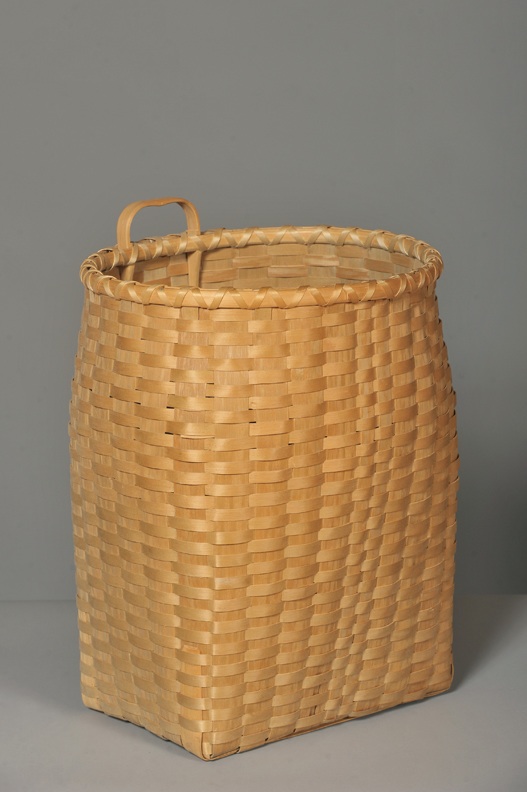 Baskets made of black ash splints have a long history in the local Mohawk community as durable containers made for hard use. Because hunters and trappers carried heavy tools and their catch, the best baskets have been made from thick, hand-pounded splints woven tightly into forms iconic of our region. Henry Arquette is known in his community as a master of weaving work baskets in the traditional manner. Among his other products are market baskets, corn washers, picnic baskets, and ceremonial baskets for traditional longhouse weddings.
Baskets made of black ash splints have a long history in the local Mohawk community as durable containers made for hard use. Because hunters and trappers carried heavy tools and their catch, the best baskets have been made from thick, hand-pounded splints woven tightly into forms iconic of our region. Henry Arquette is known in his community as a master of weaving work baskets in the traditional manner. Among his other products are market baskets, corn washers, picnic baskets, and ceremonial baskets for traditional longhouse weddings.
Angel Gabriel Weathervane
Unidentified artist, Wevertown, ca. 1830
Courtesy of Adirondack Museum
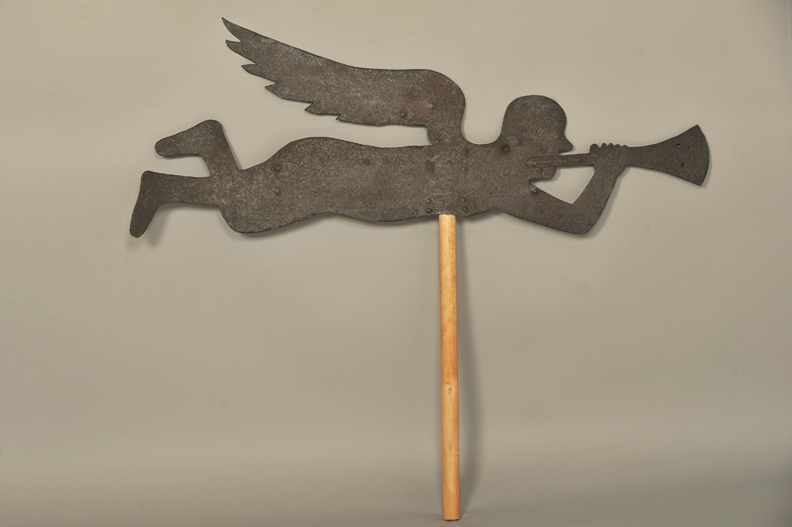 This sheet metal weathervane in the form of the archangel Gabriel is said to have flown over a sawmill in Wevertown in the mid-19th century. Before modern forecasting, farmers and other rural people relied on weathervanes to detect changes in the wind that could affect their work. Most often on church steeples, the winged figure of Gabriel with a trumpet in hand was a popular motif of the time, as a herald of great tidings during a period of religious revival in the United States.
This sheet metal weathervane in the form of the archangel Gabriel is said to have flown over a sawmill in Wevertown in the mid-19th century. Before modern forecasting, farmers and other rural people relied on weathervanes to detect changes in the wind that could affect their work. Most often on church steeples, the winged figure of Gabriel with a trumpet in hand was a popular motif of the time, as a herald of great tidings during a period of religious revival in the United States.
Wooden Maple Sugar Mold
Unidentified artist, Massena area, date unknown
Courtesy of Madeleine Gray
 In French Canada, maple sugar was cooked down to sugar for long-term storage. Often, the sugar was place in hand-carved hardwood molds to make attractive cakes of sugar.
In French Canada, maple sugar was cooked down to sugar for long-term storage. Often, the sugar was place in hand-carved hardwood molds to make attractive cakes of sugar.
Sampler Tied Quilt
Johnsburg United Methodist Church Women, Johnsburg, 1992
Courtesy of the Folklife Center at Crandall Public Library
Tying layers of fabric together, rather than quilting with elaborately stitched patterns, makes warm bedcovers, is faster and easier than quilting, and provides occasions for group socializing. This tied full-size comforter, pieced with 35 different traditional quilt block patterns, was made by the Johnsburg UMC womenas a fundraiser. Typically, such sewing groups have made quilts to give to the needy in their community, to send abroad for church-sponsored relief efforts, or to sell for raising funds for the church.








